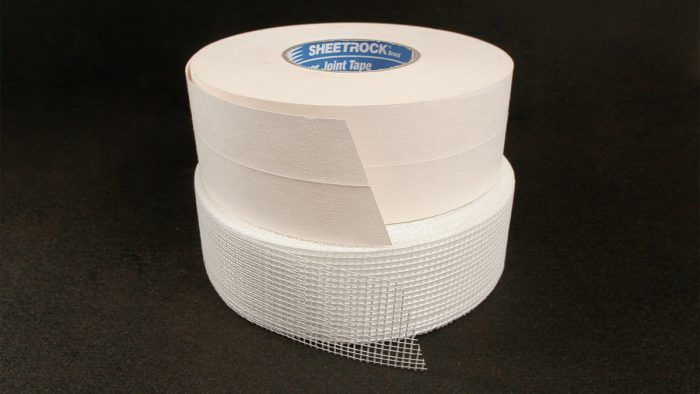What’s the Difference: Paper and Fiberglass Mesh Drywall Tape
You can use either tape, but each one has advantages in specific situations.

Although various specialty tapes exist, the choice of tape in most drywall installations comes down to two products: paper or fiberglass mesh. Most joints can be taped with either one, but before you start mixing compound, you need to know the important differences between the two.
Paper Drywall Tape
• Because paper tape is nonadhesive, it must be embedded in a layer of joint compound to stick to the drywall surface. This is easy enough to do, but if you’re not careful to cover the entire surface with compound and then to squeeze it out evenly, air bubbles will form under the tape.
• Although mesh tape can be used on inside corners, paper is much easier to handle in these locations because of its middle crease.
• Paper is not as strong as fiberglass mesh; however, it is nonelastic and will create stronger joints. This is especially important at butt joints, which typically are the weakest areas in a drywall installation.
• Paper tape can be used with either drying-type or setting-type compound.
Cost: $1.55 per 250-ft. roll
Fiberglass-Mesh Drywall Tape

• Fiberglass-mesh tape is self-adhesive, so it doesn’t need to be embedded in a layer of compound. This speeds up the taping process and ensures that the tape will lie flat on the drywall surface. It also means that you can apply the tape to all seams in a room before putting on the first coat of compound.
• Although stronger than paper tape in ultimate load, mesh tape is more elastic, so joints are more likely to develop cracks.
• Mesh tape should be covered with setting-type compound, which is stronger than drying type and will compensate for fiberglass mesh’s greater elasticity. After the initial coat, either type of compound can be used.
• With patches, where joint strength is not as much of a concern as with a full sheet, mesh tape allows for a faster fix.
• Manufacturers approve the use of paper tape for paperless drywall, but mesh tape provides the best protection against mold.
• For an inside-corner gap wider than 1/4-in., mesh tape and a layer of compound to fill the gap provide a good substrate for finishing the corner with paper tape. If you’re doing an airtight-drywall installation (see “How to Hang Airtight Drywall,” FHB #229), however, be sure to fill the gap with canned foam before finishing.
Cost: $4.85 per 150-ft. roll
For more information:
More on Drywall
Drywall: Finishing an inside corner – In this article, learn how to use drywall to finish an inside corner using a system of taping and mudding. A good system improves the look of every room in your house and saves time.
Drywall: Finishing an outside corner – Drywall: Finishing an outside corner – Finishing drywall can be a tricky art to master. A pro demonstrates how he creates a smooth finish by applying the right amount of compound and pressure to the corner bead.
Hanging Drywall – Watch Myron R. Ferguson demonstrate his techniques for smooth, hassle-free drywall hanging.
Invisible Drywall Seams – Create perfect walls with minimal mess, effort, and frustration.
Taping New Drywall to Existing, Painted Drywall – Q: I’m replacing 3 ft. of drywall along the bottom of an existing wall. The drywall above is in good condition and is painted with satin latex paint…


View Comments
I totally agree with this article. Tape corners and butt-joints with paper tape and tapered joints with mesh tape.
I recommend checking out "FibaFuse." it's a non-woven fiberglass tape from St. Gobain, generally available from The Big Orange Box if you ask nicely and persistently. Note, FibaFUSE, not FibaTAPE.
It has the advantages of mesh tape, in that it's permeable, so you don't get bubbles and you can just mash the mud through it to cure dry spots. It's also a bit stronger than paper. Cost is less than mesh, more than paper.
It can be used in most production tools, but it shines in repairs, because it's much thinner than mesh and about half the thickness of paper, which means you don't have to feather it out as far, a real advantage, especially when the wall is textured. One downside is its flexibility- it can fold back on itself if you don't trowel carefully. As a professional handyman, I do almost exclusively repairs and FibaFuse is the only tape I carry in my van.